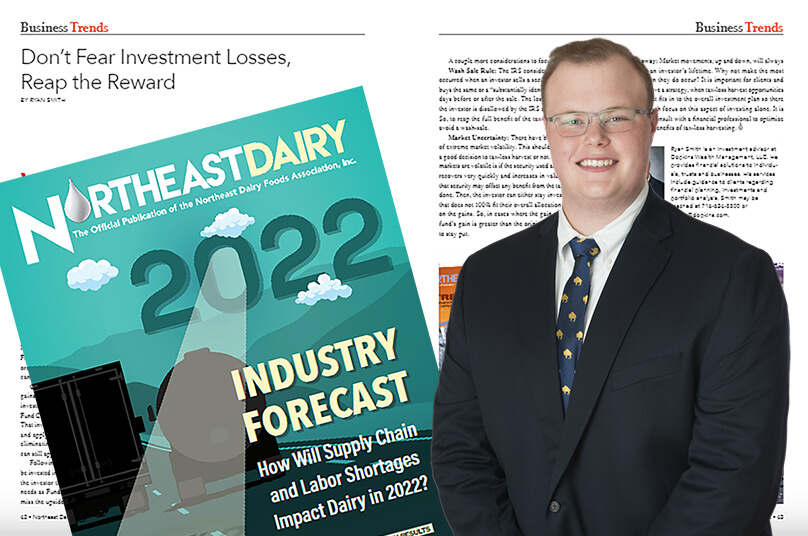Don’t Fear Investment Losses, Reap the Reward
September 29, 2021 | Authored by Ryan C. Smith CFP®
Ryan Smith’s article was originally published by Dopkins on September 29, 2021, and reprinted with our permission in the Q1 2022 edition of Northeast Dairy Magazine.
Don’t Fear Investment Losses, Reap the Reward
While markets are expected to climb over time, periodic downturns happen. When they do, it leaves most investors a bitter taste in their mouth. That is why it can be beneficial to look for opportunities to make the most of these down ticks in the market through tax-loss harvesting.
Let’s take a look at how tax-loss harvesting works:
- You sell an investment that has unrealized losses, once sold now they are recognized.
- Use, the proceeds from the sell are reinvested into a different security that fits the investment profile of the original position.
- Then, come tax time, you can use up to $3,000 of that recognized loss to offset ordinary income or use 100% of the “loss” to offset other capital gains in the portfolio.
It might help to see an illustration:
An investor purchases Fund A for $15,000. Twelve months and one day later, it’s worth $10,000. They decide to harvest the long-term, $5,000 loss (long-term because the fund was for a year plus one day). From that $5,000 loss, $3,000 of it could be used to offset ordinary income from that tax year and the remaining $2,000 can be used in future years.
Capital losses that are harvested can be applied to capital gains too, not just ordinary income. For instance, the same investor from before but they own another security, Fund C. Fund C has gains of $2,000 that were realized earlier in the year. That investor can use the losses from Fund A (total of $5,000) and apply $2,000 of that loss to offset the gain, effectively eliminating taxes on that gain. Then, the remaining $3,000 can still applied to offset ordinary income.
Following the sale of Fund A, the $10,000 in proceeds would be invested into a different security, Fund B. The goal is to give the investor the same market exposure to fit their allocation needs as Fund A did. By doing this, there is no potential to miss the upside of market movements. After 30 days, wash sale rules no longer apply and the investor can move back to the original security, Fund A.
Let’s take this one step further:
If that investor uses that $3,000 to offset their ordinary income and we put them in the 30% marginal tax rate, they could receive a current income tax benefit of up to $900 ($3,000 × 30% = $900). Being a prudent investor, they put their tax savings back in the market. Assuming an average annual return of 6% and a tax-loss harvesting benefit of $900 being reinvested each year, they could potentially amount to approximately $35,000 after 20 years.
Key Factors When Considering the Benefits of Tax-Loss Harvesting
- Account Type: Tax-loss harvesting isn’t useful in retirement accounts such as a 401(k) or IRA, because the losses generated in a tax-deferred account cannot be deducted.
- Type of Loss: A long-term loss would first be applied to a long-term gain. A short-term loss would be applied to a short-term gain. Any excess losses, from short-term or long-term, can be used to offset gains of either category.
A couple more considerations to focus on:
Wash Sale Rule
The IRS considers a wash-sale to have occurred when an investor sells a security for a loss and then buys the same or a “substantially identical” security within 30 days before or after the sale. The loss that was expected by the investor is disallowed by the IRS and it is not deductible. So, to reap the full benefit of the tax-loss, an investor must avoid a wash-sale.
Market Uncertainty
There have been and will be times of extreme market volatility, this should play a role in if it is a good decision to tax-loss harvest or not. The main risk when markets are volatile is if the security used as “the replacement” recovers very quickly and increases in value, the gains from that security may offset any benefit from the tax-loss harvesting done. Then, the investor can either stay invested in a security that does not 100% fit their overall allocation or pay the taxes on the gains. So, in cases where the gain of the replacement fund’s gain is greater than the original fund’s loss, it is best to stay put.
Takeaway
Market movements, up and down, will always occur over an investor’s lifetime. Why not make the most of them when they do occur? It is important for clients and advisors to have a strategy, when tax-loss harvest opportunities arise; one that fits in to the overall investment plan so there is not too much focus on this aspect of investing alone. It is beneficial to consult with a financial professional to optimize the potential benefits of tax-loss harvesting.
For a printable copy of this article, please click here.
For more information, contact Ryan Smith at rsmith@dopkins.com.
* Dopkins Wealth Management, LLC is a registered investment advisor owned by the partners of Dopkins & Company, LLP.
© Dopkins Wealth Management, LLC
Important Disclosures: The information provided here is for general informational purposes only and should not be considered an individualized recommendation or personalized investment advice. The investment strategies mentioned here may not be suitable for everyone. Each investor needs to review an investment strategy for his or her own particular situation before making any investment decision.
All expressions of opinion are subject to change without notice in reaction to shifting market conditions. Data contained herein from third-party providers is obtained from what are considered reliable sources. However, its accuracy, completeness or reliability cannot be guaranteed.
Rebalancing strategies do not ensure a profit and do not protect against losses in declining markets. Rebalancing may cause investors to incur transaction costs, and when rebalancing a nonretirement account, taxable events may be created that may affect your tax liability.
Examples provided are hypothetical and for illustrative purposes only and not intended to be reflective of results you can expect to achieve.
This information is not intended to be a substitute for specific individualized tax, legal or investment planning advice. Where specific advice is necessary or appropriate, Schwab recommends consultation with a qualified tax advisor, CPA, Financial Planner or Investment Manager.
Investing involves risks, including loss of principal.
Sources:
Reap the Benefits of Tax-Loss Harvesting (schwab.com)

About the Author
Ryan C. Smith CFP®
Ryan provides financial solutions to individuals, trusts and businesses. His services include guidance to clients regarding financial planning, investments and portfolio analysis.
 To read the article in Northeast Dairy Magazine, please click here & scroll to online pages 44-45 (print edition pages 42-43.)
To read the article in Northeast Dairy Magazine, please click here & scroll to online pages 44-45 (print edition pages 42-43.) 
